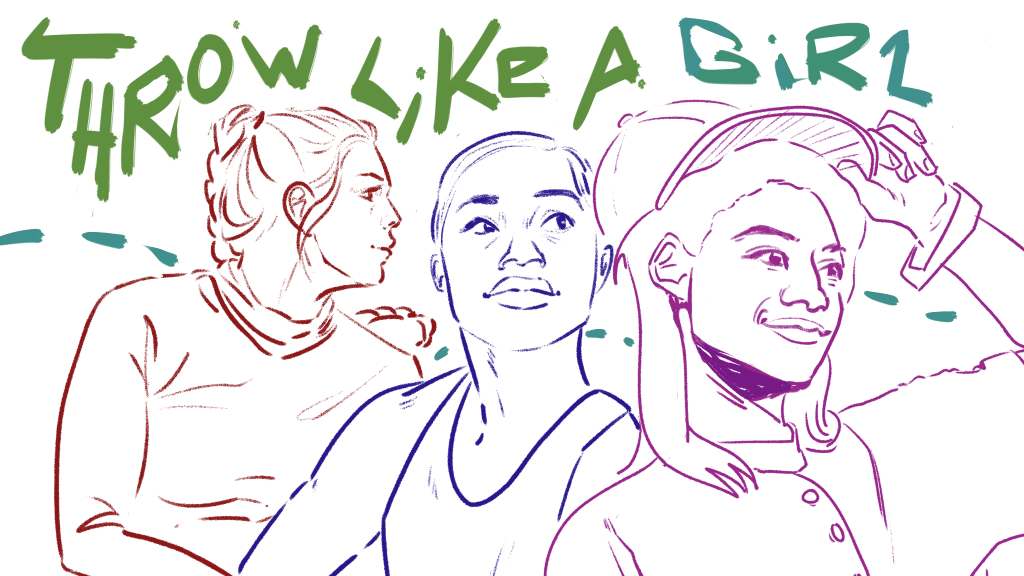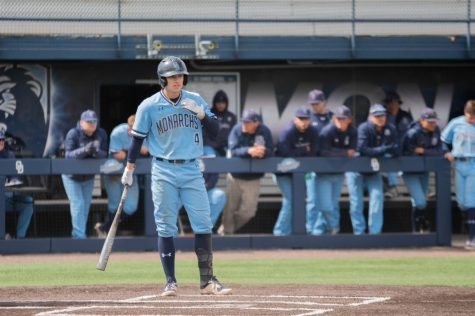Posted on 30 March 2022.

Even elite female athletes struggle to shake the stigma of ‘playing like a girl.’ (Athletes pictured, from left: Sarah Fuller, Allyson Felix and Mo’ne Davis) (Ha-tien Nguyen/Photo Editor)
This is the final piece of a series of articles for Women’s History Month spotlighting female empowerment through sports.
“You throw like a girl!”
When I was younger, I learned to anticipate this banter from the boys in my life. I grew up with many uncles and cousins who were former high school and collegiate athletes, and the girls were always expected to keep up with the boys. My dad prioritized teaching me how to catch a football, dribble a basketball and hit a baseball as soon as I was physically capable. My younger brother and I constantly competed in athletic contests, and were evenly matched in all of them.
At family gatherings, it was tradition to organize backyard wiffle ball games. Inevitably, the boys would nonchalantly catch my pop flies and easily beat my throws to first base, at which point one of them would remind me of my inadequacy: “You play like a girl!”
“But I am a girl!” I’d scream back, confused and frustrated by the impossibility of matching the boys’ athleticism. Each passing year only exacerbated the hopelessness I felt as I watched my brothers, cousins and male peers become exponentially taller, stronger and faster than me.
In high school, I played basketball games in nearly empty gymnasiums. The crowds only began to trickle in during the waning minutes of the fourth quarter, hoping to secure their seats before the boys’ game began. At home I would scroll through the TV channels in search of broadcasts of women’s college games and rarely found one. “Playing like a girl” had once seemed like a trifling insult, but it proved to be a prophetic warning: female athletes cease to be interesting when they can no longer keep up with the boys.
When Mo’ne Davis burst onto the Little League World Series scene in 2014, I was in awe of her confidence and ability to hold her own in the boys’ club that is baseball. Although I looked up to her, I recognized that following in her footsteps would lead me to a dead end. I knew that the time would come when the athletic gap between Davis and her male teammates would be insurmountable. Eventually, biology would push even a player of her caliber out of baseball and, consequently, she would no longer be noteworthy.
Davis, who now plays softball at Hampton University (Va.), once appeared to be an exception to the rule. But at no fault of her own she succumbed to a phenomenon common among young female athletes: when you are a girl, you will never be good enough to exist in the male-dominated sports world.
The incessant bombardment of male-dominated primetime television broadcasts, merchandise and commercials teach girls that athletic excellence is unattainable. ESPN’s list of the Top 20 Athletes from 1995-2015 featured just two women, with Serena Williams, the only woman of color, claiming the higher spot at No. 6. When women are excluded from conversations about the greatest athletes of all time, young girls with dreams of athletic renown feel that the most they can hope to achieve is second-rate status.
There is little infrastructure for women to play professional sports in the United States, which means that the highest competition they can aspire to reach is the collegiate level. Unfortunately, the NCAA has repeatedly treated its female athletes like afterthoughts. Perhaps the most embarrassing display of disrespect is the stark difference between the amenities provided at the College World Series (CWS) and the Women’s College World Series (WCWS). Baseball players receive complementary golf outings, massages and banquets on their off days. Softball players must weather doubleheaders and play in stadiums without bathrooms or showers.
These disparities persist even though the 2021 WCWS garnered an average of 1.2 million viewers per game compared to the 2021 CWS average of 755,000. Despite evidence to the contrary, the inequitable treatment of female athletes brands women’s sports as inherently lesser to men’s.
Additionally, female athletes who attempt to place their personal desires above their athletic performance risk losing financial support. When seven-time Olympian gold medalist Allyson Felix revealed the pay discrimination she faced during her pregnancy, companies only revised their maternity policies due to immense public outcry. The swift and unforgiving pay cuts Felix and other Nike-sponsored athletes, many of whom were women of color, received upon becoming mothers unambiguously proclaimed that when female athletes prioritize their womanhood, their worth decreases. Meanwhile, nonbinary and transgender athletes can struggle to find their place in an industry that seeks to definitively place athletes into one of two gender categories.
Female athletes face an impossible catch-22: their displays of speed and strength aren’t masculine enough to warrant intrigue and media coverage, yet they aren’t allowed to fully explore their femininity. Even when their playing days are behind them, they face undue criticism and scrutiny over how they present themselves, especially women of color. Texas A&M University assistant women’s basketball coach Sydney Carter was branded “unprofessional” for donning pink pants and heels during a game; meanwhile, nobody bats an eye when male coaches pace the sidelines sporting sweatpants.
Being a female athlete can also be degrading and sometimes outright dangerous. Former Vanderbilt University (Tenn.) goalkeeper Sarah Fuller was lampooned online, mostly by men diminishing her accomplishment, after she became the first woman to score in a Power 5 college football game. Male authority figures can abuse young female athletes for years without facing consequences. The sports community praised NBA forward Kevin Love, a white man, for coming forward about his mental health struggles, but professional tennis player Naomi Osaka, a Hatian and Japanese woman, faced ridicule and disparagement.
Although male athletes have the upper hand when it comes to physical strength, the emotional and mental fortitude female athletes possess is far more impressive. To constantly be defending your right to equal recognition and protection is an exhausting burden, and it doesn’t get any easier in the male-dominated sports arena. I am continuously disappointed to see the female athletes I idolize not only be relegated to back-page news stories and secondary sports channels, but also dismissed as inherently mediocre.
Certainly, women’s sports are far more visible and celebrated today than they were when I was growing up. More and more female athletes are proving they can be global icons who transcend athletics, achieve a work-life balance and do what was formerly impossible.
I want my little sister and all young girls to see that female athletes can be more than just successful: they can be the standard, regardless of gender. I want them to see that playing sports as a girl does not deserve ridicule or mockery — it is something worthy of praise. I want them to know that their perseverance in the face of opposition defines their worth, not their ability to keep up with the boys.
After all, of course female athletes throw, hit, run, shoot and play like a girl. That is all that should be asked of them, because that is more than enough.
The post The casual cruelty of the phrase ‘throw like a girl’ appeared first on The Emory Wheel.







